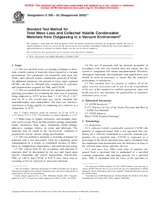Wir benötigen Ihre Einwilligung zur Verwendung der einzelnen Daten, damit Sie unter anderem Informationen zu Ihren Interessen einsehen können. Klicken Sie auf "OK", um Ihre Zustimmung zu erteilen.
ASTM E595-93(2003)e1
Standard Test Method for Total Mass Loss and Collected Volatile Condensable Materials from Outgassing in a Vacuum Environment (Includes all amendments And changes 8/16/2017).
Automatische name übersetzung:
Standard Test Method for Gesamtmassenverlustund Collected Volatile Kondensierbare Materialien von Ausgasen in einer Vakuumumgebung
NORM herausgegeben am 1.10.2003
Informationen über die Norm:
Bezeichnung normen: ASTM E595-93(2003)e1
Anmerkung: UNGÜLTIG
Ausgabedatum normen: 1.10.2003
SKU: NS-47334
Zahl der Seiten: 8
Gewicht ca.: 24 g (0.05 Pfund)
Land: Amerikanische technische Norm
Kategorie: Technische Normen ASTM
Die Annotation des Normtextes ASTM E595-93(2003)e1 :
Keywords:
material selection, material test, Outgassing, screening test, spacecraft materials, Total Mall Loss (TML), Volatile Condensable Materials (VCM)
Ergänzende Informationen
| 1. Scope | ||
|
1.1 This test method covers a screening technique to determine volatile content of materials when exposed to a vacuum environment. Two parameters are measured: total mass loss (TML) and collected volatile condensable materials (CVCM). An additional parameter, the amount of water vapor regained (WVR), can also be obtained after completion of exposures and measurements required for TML and CVCM. 1.2 This test method describes the test apparatus and related operating procedures for evaluating the mass loss of materials being subjected to 125°C at less than 7 X 10-3 Pa (5 X 10 -5 torr) for 24 h. The overall mass loss can be classified into noncondensables and condensables. The latter are characterized herein as being capable of condensing on a collector at a temperature of 25°C. Note 1—Unless otherwise noted, the tolerance on 25 and 125°C is ± 1°C and on 23°C is ± 2°C. The tolerance on relative humidity is ± 5%. 1.3 Many types of organic, polymeric, and inorganic materials can be tested. These include polymer potting compounds, foams, elastomers, films, tapes, insulations, shrink tubings, adhesives, coatings, fabrics, tie cords, and lubricants. The materials may be tested in the "as-received" condition or prepared for test by various curing specifications. 1.4 This test method is primarily a screening technique for materials and is not necessarily valid for computing actual contamination on a system or component because of differences in configuration, temperatures, and material processing. 1.5 The criteria used for the acceptance and rejection of materials shall be determined by the user and based upon specific component and system requirements. Historically, TML of 1.00% and CVCM of 0.10% have been used as screening levels for rejection of spacecraft materials. 1.6 The use of materials that are deemed acceptable in accordance with this test method does not ensure that the system or component will remain uncontaminated. Therefore, subsequent functional, developmental, and qualification tests should be used, as necessary, to ensure that the material's performance is satisfactory. 1.7 This standard does not purport to address all of the safety problems associated with its use. It is the responsibility of the user of this standard to establish appropriate safety and health practices and determine the applicability of regulatory limitations prior to use. |
||
| 2. Referenced Documents | ||
|
Empfehlungen:
Aktualisierung der technischen Normen
Wollen Sie sich sicher sein, dass Sie nur die gültigen technischen Normen verwenden?
Wir bieten Ihnen eine Lösung, die Ihnen eine Monatsübersicht über die Aktualität der von Ihnen angewandten Normen sicher stellt.
Brauchen Sie mehr Informationen? Sehen Sie sich diese Seite an.




 Cookies
Cookies
